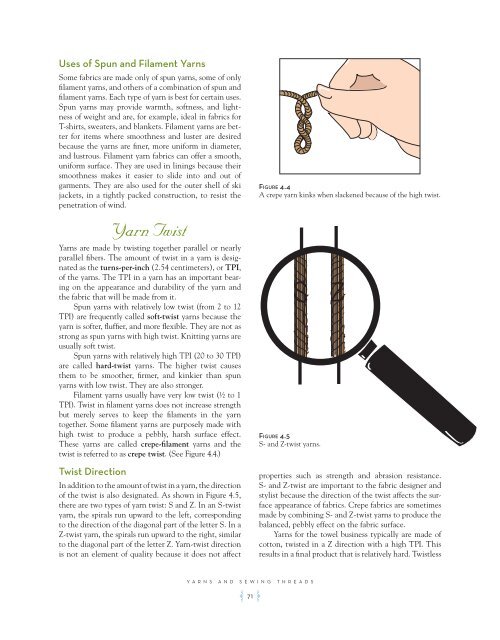You also want an ePaper? Increase the reach of your titles
YUMPU automatically turns print PDFs into web optimized ePapers that Google loves.
Uses of Spun and Filament Yarns<br />
Some fabrics are made only of spun yarns, some of only<br />
filament yarns, and others of a combination of spun and<br />
filament yarns. Each type of yarn is best for certain uses.<br />
Spun yarns may provide warmth, softness, and lightness<br />
of weight and are, for example, ideal in fabrics for<br />
T-shirts, sweaters, and blankets. Filament yarns are better<br />
for items where smoothness and luster are desired<br />
because the yarns are finer, more uniform in diameter,<br />
and lustrous. Filament yarn fabrics can offer a smooth,<br />
uniform surface. They are used in linings because their<br />
smoothness makes it easier to slide into and out of<br />
garments. They are also used for the outer shell of ski<br />
jackets, in a tightly packed construction, to resist the<br />
penetration of wind.<br />
Yarn Twist<br />
Yarns are made by twisting together parallel or nearly<br />
parallel fibers. The amount of twist in a yarn is designated<br />
as the turns-per-inch (2.54 centimeters), or TPI,<br />
of the yarns. The TPI in a yarn has an important bearing<br />
on the appearance and durability of the yarn and<br />
the fabric that will be made from it.<br />
Spun yarns with relatively low twist (from 2 to 12<br />
TPI) are frequently called soft-twist yarns because the<br />
yarn is softer, fluffier, and more flexible. They are not as<br />
strong as spun yarns with high twist. Knitting yarns are<br />
usually soft twist.<br />
Spun yarns with relatively high TPI (20 to 30 TPI)<br />
are called hard-twist yarns. The higher twist causes<br />
them to be smoother, firmer, and kinkier than spun<br />
yarns with low twist. They are also stronger.<br />
Filament yarns usually have very low twist (½ to 1<br />
TPI). Twist in filament yarns does not increase strength<br />
but merely serves to keep the filaments in the yarn<br />
together. Some filament yarns are purposely made with<br />
high twist to produce a pebbly, harsh surface effect.<br />
These yarns are called crepe-filament yarns and the<br />
twist is referred to as crepe twist. (See Figure 4.4.)<br />
Twist Direction<br />
In addition to the amount of twist in a yarn, the direction<br />
of the twist is also designated. As shown in Figure 4.5,<br />
there are two types of yarn twist: S and Z. In an S-twist<br />
yarn, the spirals run upward to the left, corresponding<br />
to the direction of the diagonal part of the letter S. In a<br />
Z-twist yarn, the spirals run upward to the right, similar<br />
to the diagonal part of the letter Z. Yarn-twist direction<br />
is not an element of quality because it does not affect<br />
YARNS AND SEWING THREADS<br />
A 71 F<br />
Figure 4.4<br />
A crepe yarn kinks when slackened because of the high twist.<br />
Figure 4.5<br />
S- and Z-twist yarns.<br />
properties such as strength and abrasion resistance.<br />
S- and Z-twist are important to the fabric designer and<br />
stylist because the direction of the twist affects the surface<br />
appearance of fabrics. Crepe fabrics are sometimes<br />
made by combining S- and Z-twist yarns to produce the<br />
balanced, pebbly effect on the fabric surface.<br />
Yarns for the towel business typically are made of<br />
cotton, twisted in a Z direction with a high TPI. This<br />
results in a final product that is relatively hard. Twistless













